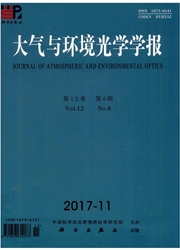

 中文摘要:
中文摘要:
Ring效应描述了由于大气的转动Raman散射导致的太阳夫琅禾费线变弱的现象,这种现象受气溶胶光学性质的影响,因此可以通过模拟Ring效应反映气溶胶状况。研究了基于MonteCarlo大气辐射传输模型(McArtim)模拟计算Ring效应的方法。采用合适的大气参数带入模型,计算总光子中发生转动Raman散射的光子数的概率来衡量Ring效应的强度,并将模拟计算的Ring强度结果和MAX-DOAS系统实测的Ring效应强度进行对比,得到了较好的一致性。结果表明,通过大气辐射传输模型模拟计算Ring效应具有快速特点,在未来的工作中将结合MAX—DOAS技术,利用Ring效应模拟反演大气气溶胶状况。
 英文摘要:
英文摘要:
Ring effect is defined as the phenomenon that the depth of solar Fraunhofer lines in scattered light is less than those observed in direct sunlight. And today it is commonly agreed that rotational Raman scattering on atmospheric molecules is the dominant source for the Ring effect. The Ring effect is affected by the optical properties of aerosol. And thus the aerosol information can be retrieved from the measured strength of the Ring effect. A novel method is presented to simulate Ring effect based on the Monte Carlo atmospheric radiative transfer model (McArtim). The average probability of photons that have undergone rotational Raman scattering (RRS) event is calculated under different atmospheric situations, which represents corresponding strength of Ring effect. A comparison of the results of Ring effect between simulation and measurement with MAX-DOAS shows a good agreement. The result indicates the Ring effect can be calculated rapidly with radiative transfer model. The simulation technique can be combined with the MAX-DOAS measurement to retrieve the properties of aerosols in the future
 同期刊论文项目
同期刊论文项目
 同项目期刊论文
同项目期刊论文
 期刊信息
期刊信息
